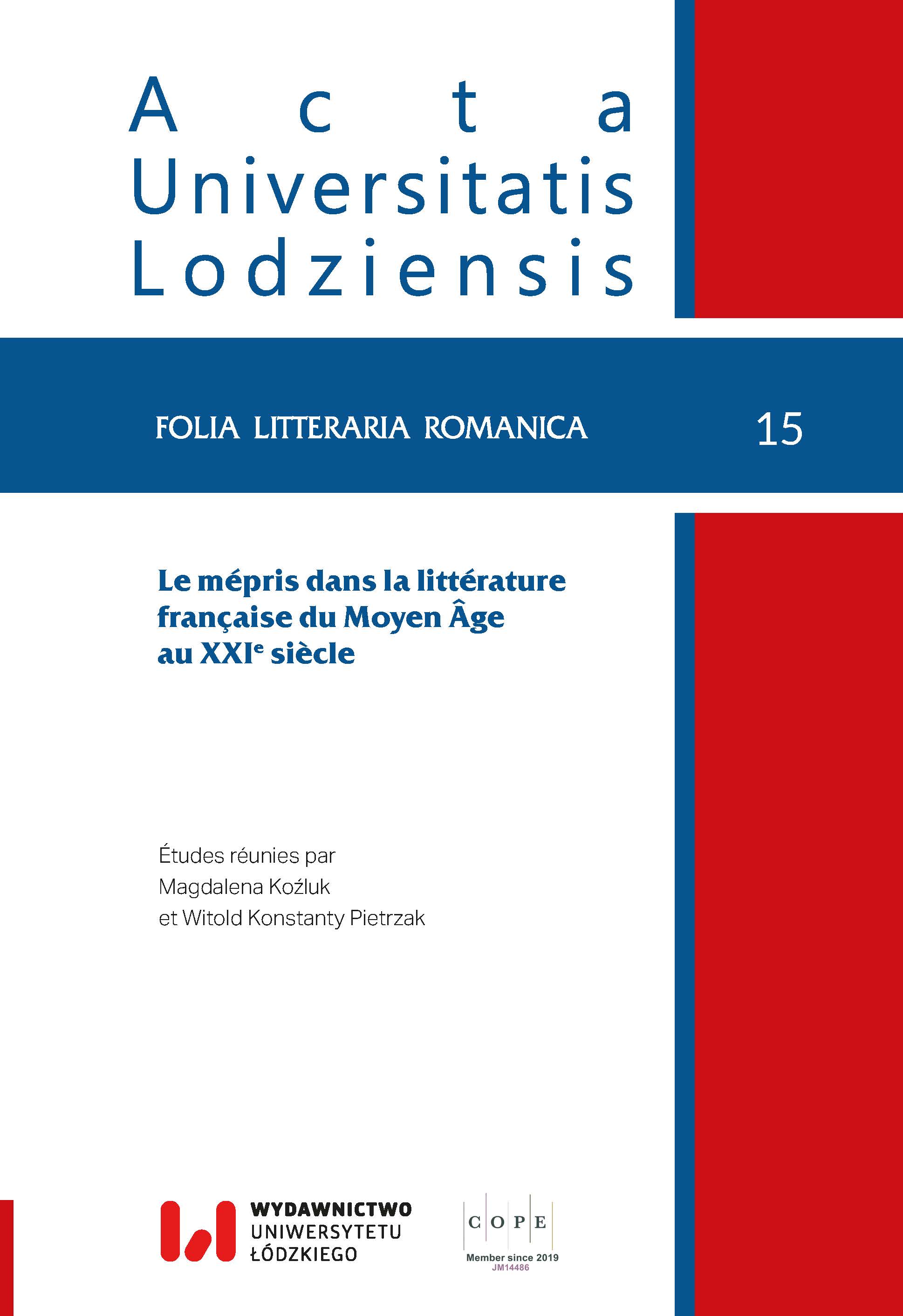“‘Chascun qui entre est entaiez’. Contempt in Béroul’s Tristan”
DOI:
https://doi.org/10.18778/1505-9065.15.02Keywords:
Béroul, Tristan and Isolde, passion, contempt, leprosy, dirtAbstract
The article analyses the place of contempt in Béroul’s Romance of Tristan. Since its appearance in literature, the love of Tristan and Isolde has been the object of a double perception: on the one hand, a valued image of the “martyrdom of love”, and on the other hand, the much less positive image of a degrading, even despicable passion. It is interesting to note that contempt does not only appear in polemical works, but is, on the contrary, already present in the source text, especially in Béroul’s version. An in-depth study of the terms used to describe passion (including those used by the protagonists themselves), an analysis of the play of masks and of the episodes that stage the particularly humiliating situations in which all the characters without exception find themselves, reveals an ironic and sarcastic look by the author, and highlights the sometimes brutal, even cynical tone of the work. The analysis focuses on the major episodes of the story: the scene of the “clandestine rendezvous”, Tristan’s disguise as a leper and Isolde’s “ambiguous oath” (the crossing of the marsh).
Downloads
References
Batany, Jean, « Le Tristan de Béroul : une tragédie ludique », in L’Hostellerie de Pensée. Études sur l’art littéraire au Moyen Âge offertes à Daniel Poirion par ses anciens élèves, Paris, Presses de l’Université de Paris-Sorbonne, 1995, p. 27-39
Google Scholar
Bennett, Philip E., « Jugement de Dieu ; parole d’auteur. Béroul et le débat sur l’intentionnalité au XIIe siècle », in Tristan et Iseut, un thème éternel dans la culture mondiale, éd. Danielle Buschinger, Wolfgang Spiewok, Greifswald, Reineke-Verlag, 1996, p. 13-25
Google Scholar
Béroul, Tristan et Yseut, éd. Daniel Poirion, in Tristan et Yseut. Les premières versions européennes, Paris, Gallimard, 1995, p. 3-121
Google Scholar
Blakeslee, Merritt R., Love’s Masks. Identity, Intertextuality and Meaning in the Old French Tristan Poems, Cambridge, Brewer, 1989
Google Scholar
Cazelles, Brigitte, « Alexis et Tristan : les effets de l’enlaidissement », Stanford French Review, 1981, n° 5, p. 85-95
Google Scholar
Chrétien de Troyes, Romans, Paris, Le Livre de Poche, 1994
Google Scholar
Delcourt, Denyse, L’Éthique du changement dans le roman francais du XIIe siècle, Genève, Librairie Droz, 1990
Google Scholar
Demartini, Dominique, « Ivres de Dieu et d’amour, Alexis et Tristan », in L’Unique change de scène. Écritures spirituelles et discours amoureux (XIIe-XVIIe siècle), éd. Véronique Ferrer, Barbara Marczuk, Jean-René. Valette, Paris, Classiques Garnier, 2016, p. 103-121
Google Scholar
Doyle-Gates, Laura, “Precisions on the Use of Irony in Béroul’s Tristan”, Tristania, 1993, n° 14, p. 15-30
Google Scholar
Foehr-Janssens, Yasmina, La Jeune fille et l’amour. Pour une poétique courtoise de l’évasion, Genève, Droz, 2010
Google Scholar
Gaunt, Simon, Love and Death in Medieval French and Occitan Courtly Literature. Martyrs to Love, Oxford, Oxford University Press, 2006 https://doi.org/10.1093/acprof:oso/9780199272075.001.0001
Google Scholar
DOI: https://doi.org/10.1093/acprof:oso/9780199272075.001.0001
Jodogne, Omer, « Audigier et la chanson de geste avec une édition nouvelle du poème », Moyen Âge, 1960, n° 66, p. 495526
Google Scholar
Kay, Sarah, Courtly Contradictions: The Emergence of the Literary Object in the Twelfth Century, Stanford University Press, 2001
Google Scholar
Labbé, Alain, « Nature et artifice dans quelques jardins épiques », in Vergers et jardins dans l’univers médiéval, Senefiance, 1990, n° 28, URL : https://books.openedition.org/pup/2980 consulté le 21.02.2019
Google Scholar
Marie de France, Lais, éd. Karl Warnke, Paris, Le Livre de Poche, 1990
Google Scholar
Ovide, Métamorphoses, X, URL : http://bcs.fltr.ucl.ac.be/METAM/Met10/M10-519-739.htm consulté le 21.02.2019
Google Scholar
Poirion, Daniel, Notice in Béroul, Tristan et Yseut. Les premières versions européennes, Paris, Gallimard, 1995, p. 1127-1150
Google Scholar
Pomel, Fabienne, « L’écho et le masque : le fou d’amour dans la logique du double et la crise de la communication (Narcisse, Écho, Tristan, Lancelot) », in Les Fous d’amour au Moyen Âge. Orient-Occident, éd. Claire Kappler, Suzanne Thiolier-Mejean, Paris, L’Harmattan, 2007, p. 141-156
Google Scholar
Roubaud, Jacques (éd.), Les Troubadours. Anthologie billingue, Paris, Seghers, 1980
Google Scholar
Rougemont, Denis de, L’Amour et l’Occident, Paris, Librairie Plon, 1972
Google Scholar
Sargent-Baur, Barbara Nelson, “Between Fabliau and Romance: Love and Rivalry in Béroul’s Tristran”, Romania, 1984, t. 10, n° 418-419, p. 292-311 ; https://doi.org/10.3406/roma.1984.1708
Google Scholar
DOI: https://doi.org/10.3406/roma.1984.1708
Downloads
Published
How to Cite
Issue
Section
License

This work is licensed under a Creative Commons Attribution-NonCommercial-NoDerivatives 4.0 International License.












